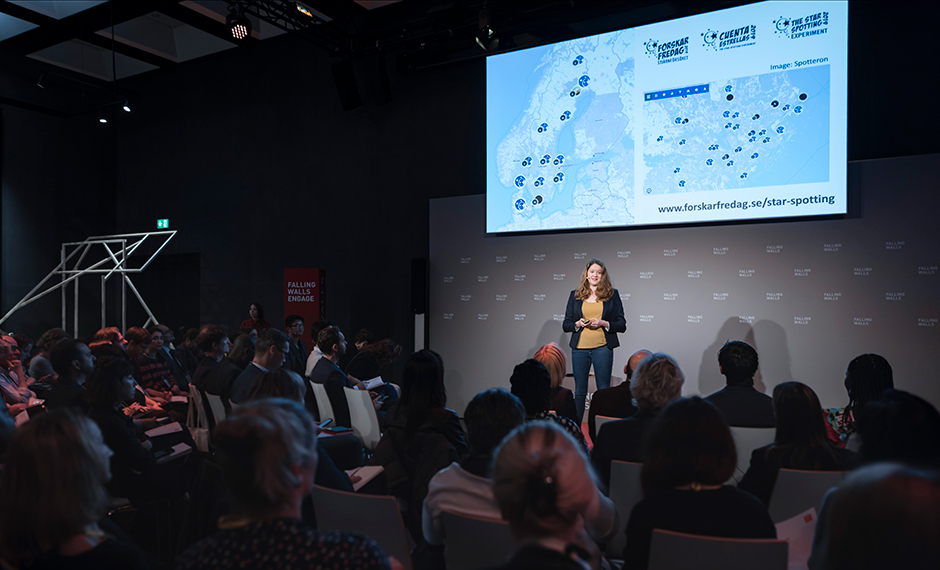The Star-Spotting Experiment, VA’s 2019 citizen science project to investigate light pollution, was shortlisted for the 2019 Falling Walls Science Engagement of the Year competition. Project manager, Lena Söderström was invited to Berlin in November to present the project in the final of the competition at the Falling Walls Conference. Here we talk to her about the experience.

Q: Firstly, could you explain a bit about the Falling Walls Engage competition and how the Star-Spotting Experiment came to be nominated?
The Falling Walls Conference is an annual global gathering organised by the Falling Walls Foundation in Berlin, always on the 9 November – the anniversary of the fall of the Berlin Wall. Falling Walls Engage is a competition for science engagement initiatives held the day before the conference.
I had presented the Star-Spotting Experiment in an international context on several occasions during the spring, inviting organisations in other countries to run the mass experiment together with us. The Star-Spotting Experiment is a citizen science project that VA (Public & Science) has been running as part of ForskarFredag, Sweden’s European Researchers’ Night 2019 programme, and we were keen to involve other countries in the project too.
After my presentation at the Eusea conference in Vienna in May, I received an email from Marie Mühlmann, Project Manager of Falling Walls Engage. She had seen my presentation and encouraged me to apply for the competition. So I sent in my application with some information about the project together with a video presentation, and in August I learned I had been selected as one of the finalists. This year the competition received 80 submissions from 40 countries, so I was delighted that the Star-Spotting Experiment was selected.
So early in the morning of the 8 November, I was one of 21 (rather nervous) finalists ready to get up on the stage and give our 5 minute presentations in front of an audience of some 100 people and the jury. The competition ran late into the afternoon, but I was the first person on stage. Prior to the competition we received training, advice and support in how to design and deliver our presentations. We also had time to get to know each other the day before.
The Falling Walls Lab and Falling Walls Venture also took place simultaneously, and the winners of the three competitions were announced on the same evening.
The conference was really well-organised and I had a lot of fun. I realised that there are so many amazing projects happening all over the world, and so much genuine passion! The best part of participating was to meet the representatives from all these projects from across the world. We had a get-together the day before the competition to prepare and to get to know each other and learn about each others’ work and experiences. I’m looking forward to stay in touch, and hopefully we can find ways to collaborate in the future.
Watch Lena Söderström presenting the Star-Spotting Experiment in the final of the Falling Walls Engage competition
Q: Tell us a bit about the other finalists and the winner
The finalists were 21 very different projects from all across the world. For example, “Lecturers without borders” is a project connecting educational institutions (schools, colleges, universities, associations) with scientists and educators across the world. “Love letter to a space rock” is an art project about a meteorite in Mexico. The “Youth University” in Austria offers children between the ages of 10-13 a five day course to experience what it is like to study at university. In “Children against antimicrobial resistance”, children in Ghana were taught about the misuse of antibiotics through story-telling and picture drawing.
The winning project was “Dreamspace Academy” in Sri Lanka, represented by Kishoth Navaretnarajah and Aravinth Panch. DreamSpace Academy is a Community Innovation Centre created to tackle authentic socio-economic and environmental challenges using Project Based Learning (PBL). The Academy works with young people from the age of 6 and provides an electronic workspace, mechanical workspace and co-working space to engage them projects that involve prototyping, research and development and one-to-one coaching.
You can read more about the finalists here and there is also a video showing highlights from the Falling Walls Engage competition.
Q: What was your experience of the Falling Walls Conference?
This was my first time at the Falling Walls Conference. The programme showcased a diverse range of current breakthrough research and facilitated networking in a number of different ways. It was really interesting to listen to high-level presentations by leading scientists and to meet so many people engaged in science and research. It would be great to see more opportunities for discussion about the role and importance of science communication and public engagement in research in future years.
European Researchers’ Night in Sweden
Each year activities are organised in around 30 cities and towns across the country under the name ForskarFredag (Researchers’ Friday). As part of the event, VA (Public & Science) coordinates a mass experiment that involves schools and members of the general public across Sweden.
